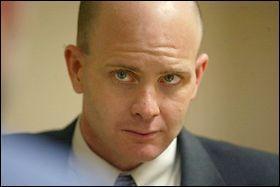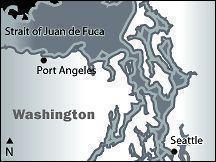 |
 |
|
|||||||
On the Case
Even Humphries, a wiry, high-energy, third-year man, was ready for a breather and a good night's sleep. But seconds into the phone conversation, he was fully alert. Agent Patrick Gahan, calling from Port Angeles, Wash., across Puget Sound on the Olympic Peninsula, was calling about an arrest Humphries had heard a bit about earlier that evening. U.S. Customs officers had detained a suspicious man coming by ferry from Canada. In his trunk were bags of white powder, mysterious chemicals and homemade timing devices. The detainee, Benni Noris, seemed to speak only French. Gahan didn't, so he was calling Humphries — who had learned French as a high-school student in Ontario, Canada — to help. Give me a few minutes to get to the office, Humphries told Gahan. When he got downtown, Humphries obtained a copy of the standard Miranda-rights card in French. He called the customs trailer in Port Angeles and spoke to the suspect on a speaker phone. Humphries read Noris his rights in French. Then he asked, "Voulez-vous parler de ce qui est arrivé?" Do you want to talk about what has occurred? "Non monsieur, je ne veux pas en parler." No sir, I do not want to talk about it. That single sentence told Humphries plenty. He asked that Gahan turn off the speaker and get on the line. What ID does this guy have? Humphries asked. A Canadian passport and baptismal certificate from Montreal, with the name Benni Antoine Noris, came the reply. "There is no way this guy is who he says he is," Humphries said. "There's no way he's from Montreal." The agent knew Quebecois French — and this wasn't it. The accent, he thought, sounded like that of a language instructor he had in the Army — a man from Algeria. Humphries, Gahan and customs officials decided to hold the suspect on suspicion of using false identification. They needed to buy time to sort this out.
The next morning, Humphries wrote up his "302," FBI parlance for the form used to detail the events of the night before. He gave it to Bob Houston, who oversees agents on the Seattle counterterrorism desk, expecting Houston to assign the case to a more experienced agent.
Humphries, 34, grew up in Steilacoom, Wash., went to high school in Canada and joined the U.S. Army. He climbed steadily through the ranks, but as a captain in military intelligence he feared he was on track to be a career pencil pusher. He decided to go back to school, winning a scholarship to the University of Tampa and studying criminology. He spent a summer during college as an intern with the Sheriff's Office in Sangamon County, Ill., where his stepfather was the chief medical examiner. He met FBI agents working on a missing-persons case, and he was hooked. Here he was with his own major international case. It was a keen responsibility — coordinating with federal prosecutors, assigning tasks, conducting interviews and keeping track of evidence. All this would be especially daunting because the Seattle office was in disarray. It had just been moved into new quarters. Agents hadn't been assigned desks or phones, and their files were stored in boxes. The one working phone line did not accept direct-dial, long-distance calls. Agents were running around with pockets full of quarters, searching for a pay phone that wasn't already tied up. At one point, FBI Director Louis Freeh called the Seattle office for an update but gave up trying to get through. When Humphries finally found a phone, he contacted the bureau's Hazardous Materials Team in Quantico, Va., and asked for specialists to join him. And he began digging for details on the mysterious Benni Noris. Noris had no criminal history in Canada and had never been to the U.S., according to a review of Canadian and U.S. databases. The next day, Humphries drove to Port Angeles with two HazMat agents and set up a post at the Port Angeles airport. There, he took a call from an FBI agent based in Ottawa, the Canadian capital. The Ottawa agent had been given a photograph by the Canadian Security Intelligence Service that might match Humphries' mysterious Mr. Noris. The agent faxed over the photo, saying only: "If this is your guy, you've got trouble." No explanation; no name. Humphries took the picture to the Clallam County Jail. The suspect looked drawn, with dark rings under his eyes. But Humphries found his resemblance to the photo unmistakable.
The man before him was not Benni Noris. But who was he?
|
|
|||||||||||||||||||||||||||||||||||||||||||||||||||||||||||||||||||||||||||||||||||||||||||
|
The Terrorist Within | Reprints seattletimes.com home |


